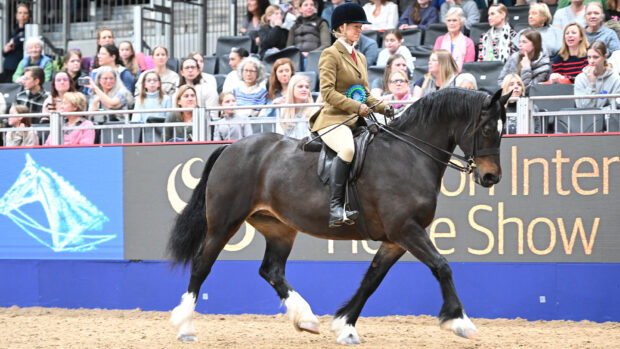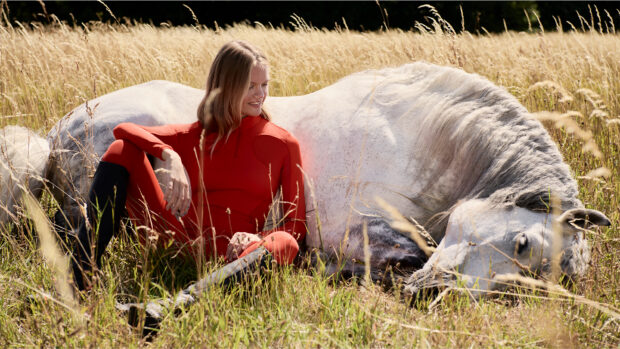The use of small plastic training aids known as Franklin balls to help riders improve their body awareness so they can send clearer signals to their horse is growing among UK equestrians. We take a look at what they are and how they work
What are Franklin balls?
Franklin balls are air- or water-filled plastic balls around 10cm in diameter (there are also massager rolls), used as part of the Franklin Method, which was developed in 1994 by Eric Franklin. Use of the balls has been taken up by some trainers and riding physios in the past five years or so, in the belief that they help communicate the horse’s movements more clearly to the rider and help improve their seat and body awareness.

Franklin balls | Amazon
These highly rated Original Franklin Method balls come in a pair and can be used both on and off the horse.
What is the science behind Franklin balls?
The Franklin Method, initially designed for dance training, helps people use their body with maximum efficiency and employs Dynamic Neuro-Cognitive Imagery (DNI) to use the brain to improve body function. The Franklin Method website (franklinmethod.com) describes DNI as using “progressive movement exercises combined with various methods of imagery” as a way of increasing awareness of “anatomical structures and locations, body biomechanics, as well as spatial and functional relationships between body segments during movement”.
Rebecca Ashton is an equestrian performance coach now based in Australia after years spent dressage training in the UK and Europe. She uses Franklin balls as part of her coaching.
“Sometimes feeling the correct way is more helpful than verbal instructions from the trainer — and often less stressful for rider, trainer and horse! When the brain learns how to execute a function or movement by doing, the lesson can often be retained in the body longer or be recalled quicker and more correctly,” she says.
“Introducing a ‘third party’ such as the Franklin Balls can help heighten sensory awareness and help connect the brain to the body. This can also help focus the rider’s energy and awareness onto themselves which helps to train focus and improve concentration and decrease the tendency to be swayed or distracted by external influences.”
How can Franklin balls help riders?
Alison Rushby is a Franklin Method teacher and Level 1 Centred Riding instructor based in Northumberland. She uses Franklin balls as part of her training.
“I use them in unmounted workshops for riders to help muscles lengthen and relax. It also gives riders more conscious control of asymmetry,” says Alison.
“The imagery work allows riders to organise their body better. One of the key teachings of the Franklin Method is visualising what is happening when you move in a specific way, by learning the position of bones, muscles and ligaments and how they move.”
How to use Franklin balls
Alison often uses the balls when working with adults either starting to ride or restarting after a long break.
“These riders tend to have issues with tension and lack of confidence, causing their muscles to stiffen and work against the horse. For example, placing a ball under each armpit holds the arms out to the side without using the muscles to support the arm – after three or four minutes, when you take the balls away you find the muscles have released across the top of the shoulders, releasing tension and allowing better contact.”
The balls can also be used to help release tension in the hip flexors, which in turn allows the leg to drop by an inch or more. Doing a series of these exercises teaches the rider what it feels like when releasing the hip flexor, and how in turn the horse becomes more responsive to the seat and leg, says Alison.
“Ultimately, they can help riders work more effectively with the horse. When you see dressage riders with excessive head bobbing, for example, often they are not absorbing the movement of the horse correctly and so not getting the most out of the partnership.”
Rebecca Ashton uses them both during ridden and unmounted sessions.
“Sometimes I use the balls in the middle of a riding lesson and get the rider off the horse, do a movement and get back into the saddle again to feel the difference immediately. Other times they’ll be used in a ‘off the horse’ session – I often get riders to roll over tight muscles using the balls to help release tension and support correct movement.
“I use the air-filled round balls under the rider’s lower back — they might just lay there on top of the balls or roll laterally or even longitudinally to help release the lower back. This can help reduce tension in the sacroiliac area and help muscles to slide over muscles and assist myofascial release,” says Rebecca, who uses the ‘Peanut’ ball under the shoulder blades to help decrease tension in the shoulder area.
“I even use the balls to release the jaw and feet! The tension in the jaw can work its way right through the body.
“Often tight feet and toes are overlooked with the foot in a hard, leather boot. However curled up toes can affect the joints in the legs, decreasing mobility and restricting the shock absorbing ability of the joints; this can create unstable legs or even tight legs that bring tension to and restrict the horse’s ribcage. When the rider relaxes, often so to does the horse.”

Franklin balls | Amazon
These highly rated Original Franklin Method balls come in a pair and can be used both on and off the horse.
You might also like:
- To stay up to date with all the breaking news throughout Horse of the Year Show, London International and more, subscribe to the Horse & Hound website
You may also be interested in:




